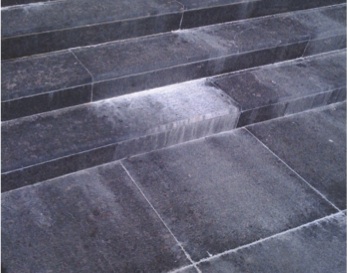Question:
We just installed a stone tile shower floor. It was sealed twice and shortly after white stuff kept showing on the floor even though the walls of the shower and the bathroom are of the same tile. We then removed the sealant and re-sealed it. Again shortly after this white stuff comes out. I have used an efflorescence cleaner which removed it, but the white stuff keeps coming back. Can you tell me what is happening and how we can fix it?
Thank you in advance for all your help.
Answer:
Without being there on site and doing several destructive tests to determine the actual cause of the problem, I can give you several of the most common causes for the condition that you have described. First of all, given the cleaning product you have described, it sounds like soluble-salt efflorescence. This soluble salt is a natural product that is present in the Portland cement-based products used most often to produce the setting bed that is under the tile installation and the grout material that is used to fill the grout joints.
Natural stone tile may contain these mineral salts as well, especially if the natural stone is a softer material such as marble or limestone. These mineral salts may, and most often do, migrate when exposed to water or water vapor. As a way to control or minimize this efflorescence, water management is of the utmost importance. Careful consideration of the materials being used should be taken into account. Efflorescence that occurs after the tile or stone installation is in service is very difficult to stop or even control. Time and use will eventually cause all the “free mineral salts” to be exhausted and the problem will go away, but to fix this problem from the beginning will most likely require a removal of the entire shower floor, and may even require removal of portions of the walls or all the walls as well.
Starting fresh with a new shower framed and ready for tile or natural stone, the methods for proper shower assemblies can be found in the TCNA Handbook for Ceramic, Glass and Stone Tile Installation. These methods show pre-sloped shower pan assemblies, weep hole protectors, references to American National Standards Institute (ANSI) for proper mixes and measures for setting beds such as 1-to-4-ratio of Portland cement to washed masonry sand used in many shower pan assemblies. The TCNA list cautions when using soft natural stone products in wet areas – if efflorescence may be of concern – a porcelain or ceramic tile that is made to resemble natural stone may be a safer choice.
A few things the NTCA Reference Manual has to say about the causes efflorescence are as follows:
- Soluble salts from the Portland cement-based products brought to the surface by capillary action where there is water or moisture present.
- Contaminated water or sand containing soluble salts.
- Excessive mineral content in the water used for maintenance.







